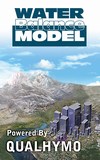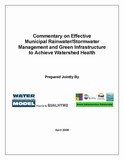Application of the Water Balance Model: Does it require more or less data than other drainage simulation tools?
Note to Reader: The following article is adapted from an email trail wherein members of the Water Balance Model team provided technical input to inform a dialogue between a municipal manager and a provincial regulator about appropriate application of the tool to inform land development decisions. The focus was on establishing performance targets for capturing rain where it falls.
What Data are Needed, Really?
The manager of development engineering services and deputy approving officer for a Vancouver Island municipality recently posed these two questions:
- Does the WBM require accurate detailed information to be entered to achieve meaningful results, information that the City does not have at this time?
- Is there an extensive track record of the effectiveness of the WBM?
“The context for these questions was an exchange of perspectives that revolved around whether and when it is appropriate for a municipality to specifically require use of the WBM,” reports Kim Stephens, Project Coordinator for the Water Sustainability Action Plan for British Columbia.
Need for Performance Targets
“The catalyst for their discussion was a Riparian Area Regulation (RAR) referral from a development proponent, and the regulator’s concerns over the impact on stream health as an outcome of site development. To better protect the riparian function, the regulator wondered what consideration the municipality is giving to establishing performance targets (at a watershed scale) for rainfall capture on individual development sites.”
“According to the regulator, the Ministry typically only receives partial information packages for development referrals; and characterized these packages as containing ‘a lot of building design and little or no engineering detail’. Although this particular municipality has for some time had a requirement for maintaining pre-development flows, the regulator observed that the requirement has not always been effective in preventing loss of instream habitat and loss of riparian function.”
“The discussion about performance targets led into a discussion about use of the WBM in order to help municipalities assess the achievability and effectiveness of developer proposals for on-site rainwater capture,” summarizes Kim Stephens.
Input Data for Water Balance Model
“Physical data is required to undertake the design of any drainage system. This is true whether one uses the WBM or any of a number of alternative analysis systems or  computer software packages,” states Jim Dumont, Engineering Applications Authority for the Inter-Provincial Partnership.
computer software packages,” states Jim Dumont, Engineering Applications Authority for the Inter-Provincial Partnership.
“Typical information needed as part of any development design process includes site specific data regarding area, slope, runoff coefficients or imperviousness, and a soil description.”
“The WBM uses the information gathered as part of a normal design process. It does not require the user to have more site information than required by any other system of design.”
“The WBM provides a substantial amount of information in the form of climate data and municipal zoning where individual municipalities have provided the zoning information. In this manner the WBM actually provides information not available in any commercial software package.”
The Calculation Engine
“ The QUALHYMO calculation engine within the WBM has been used and has been enhanced since its first application in the early 1980’s. It certainly has an extensive track record of successful use spanning some thirty (30) years across Canada and in other parts of the world.”
The QUALHYMO calculation engine within the WBM has been used and has been enhanced since its first application in the early 1980’s. It certainly has an extensive track record of successful use spanning some thirty (30) years across Canada and in other parts of the world.”
“We recognize that other analysis tools are available to municipalities and that they can be used in the design of drainage and rainwater management systems for developments and municipal works. However, we believe that the WBM has significant advantages over other available tools and is simple to use.”
To Learn More:
Click on Inter-Provincial Partnership names Jim Dumont as the Engineering Applications Authority for the Water Balance Model to learn more about his responsibilities in enhancing the WBM as a scenario modeling and decision support tool for use at the site, neighbourhood and watershed scales.
Runoff-Based Approach & Stream Health
“Of over-arching consideration, the WBM follows a ‘runoff’ based approach that stresses the assessment of the duration of flow in a stream. This approach is more scientifically defendable than the very simplistic ‘rainfall’ based approach of matching calculated peak discharge rates resulting from design storms,” continues Jim Dumont.
“This simple sounding difference is very significant for understanding and mitigating the impacts to stream stability and stream health. This approach is the reason for the creation of the WBM and its system of analysis as it is applied to environmental mitigation.”
Targets Can Accomplish Multiple Objectives
“This is why we are working towards implementing watershed targets for flow exceedance that would accomplish the most benefit for the stream. By achieving the exceedance objectives we will accomplish three objectives:
- first to provide enhanced base flows in the streams;
- second, to bring unnatural erosion under control; and
- finally, we can achieve a large degree of water quality treatment for any of the discharges to a stream.”
“The methodology embedded in the Water Balance Model enables a watershed target to be established. It also enables the user to assess how to meet the watershed target at the site scale,” concludes Jim Dumont.
Click on Water Balance Model can create an understanding of the past and compare it to many possible futures to read an article that responded to this question from a municipal Councillor: How can the Water Balance Model be applied to establish performance targets relative to an appropriate baseline condition that is acceptable to the municipality?
To Learn More:
Click on ‘Typical Year’ illustrates variable response of watershed to rainfall to download a copy of the graphic shown in the photo below. This is complemented by a 3-minute video clip on YouTube that features Jim Dumont explaining the hydrology behind the graphic to students at the University of the Fraser Valley. To view it, click here.
To download a copy of a guidance document released by the Inter-Governmental Partnership at the 2008 Water Balance Model Partners Forum, click on Establish Watershed-Specific Runoff Capture Performance Targets.
Click on Technical Manual enables Water Balance Model users to “follow the numbers” to access a highly navigable online resource, one that is organized in a manner that allows the user to understand a variety of aspects of the Water Balance Model in varying degrees of detail.
Beyond the Guidebook 2010
“This real-life example goes to the heart of what the inter-governmental partnership wishes to accomplish via Beyond the Guidebook 2010: Implementing a New Culture for Watershed Protection and Restoration in British Columbia, released in June,” states Kim Stephens.
“The Province has put in place a ‘design with nature’ policy framework that enables local governments to build and/or rebuild communities in balance with ecology. ‘Beyond the Guidebook 2010’ provides ‘how to’ guidance for developing outcome-oriented urban watershed plans, with emphasis on a necessary course correction for Integrated Stormwater Management Plans (ISMPs).”
Setting and Implementing Targets
 “In the coming weeks and months, the partnership will be highlighting the application of ‘Table 2’ as we proceed with the rollout of ‘Beyond the Guidebook 2010’. Table 2 is pivotal. It presents a conceptual framework for setting watershed-specific performance targets and then implementing them at the development scale.”
“In the coming weeks and months, the partnership will be highlighting the application of ‘Table 2’ as we proceed with the rollout of ‘Beyond the Guidebook 2010’. Table 2 is pivotal. It presents a conceptual framework for setting watershed-specific performance targets and then implementing them at the development scale.”
“There must be clear linkages between the targets and development approval processes. Financial and legal tools must also be in place to ensure implementation of outcome-oriented strategies.”
To learn more:
Click on Table 2 – Developing Outcome-Oriented Watershed Plans: Framework for Moving from Planning to Action to download a PDF of the table.
 Table 2 in ‘Beyond the Guidebook 2010’ is an updated version of the table incorporated in the Commentary on Effective Municipal Rainwater/Stormwater Management and Green Infrastructure to Achieve Watershed Health, released jointly by the Green Infrastructure Partnership and Inter-Governmental Partnership in April 2008.
Table 2 in ‘Beyond the Guidebook 2010’ is an updated version of the table incorporated in the Commentary on Effective Municipal Rainwater/Stormwater Management and Green Infrastructure to Achieve Watershed Health, released jointly by the Green Infrastructure Partnership and Inter-Governmental Partnership in April 2008.
The Commentary identifies specific actions and commitments for greening the built environment and protecting watershed health by means of affordable and effective performance targets.



